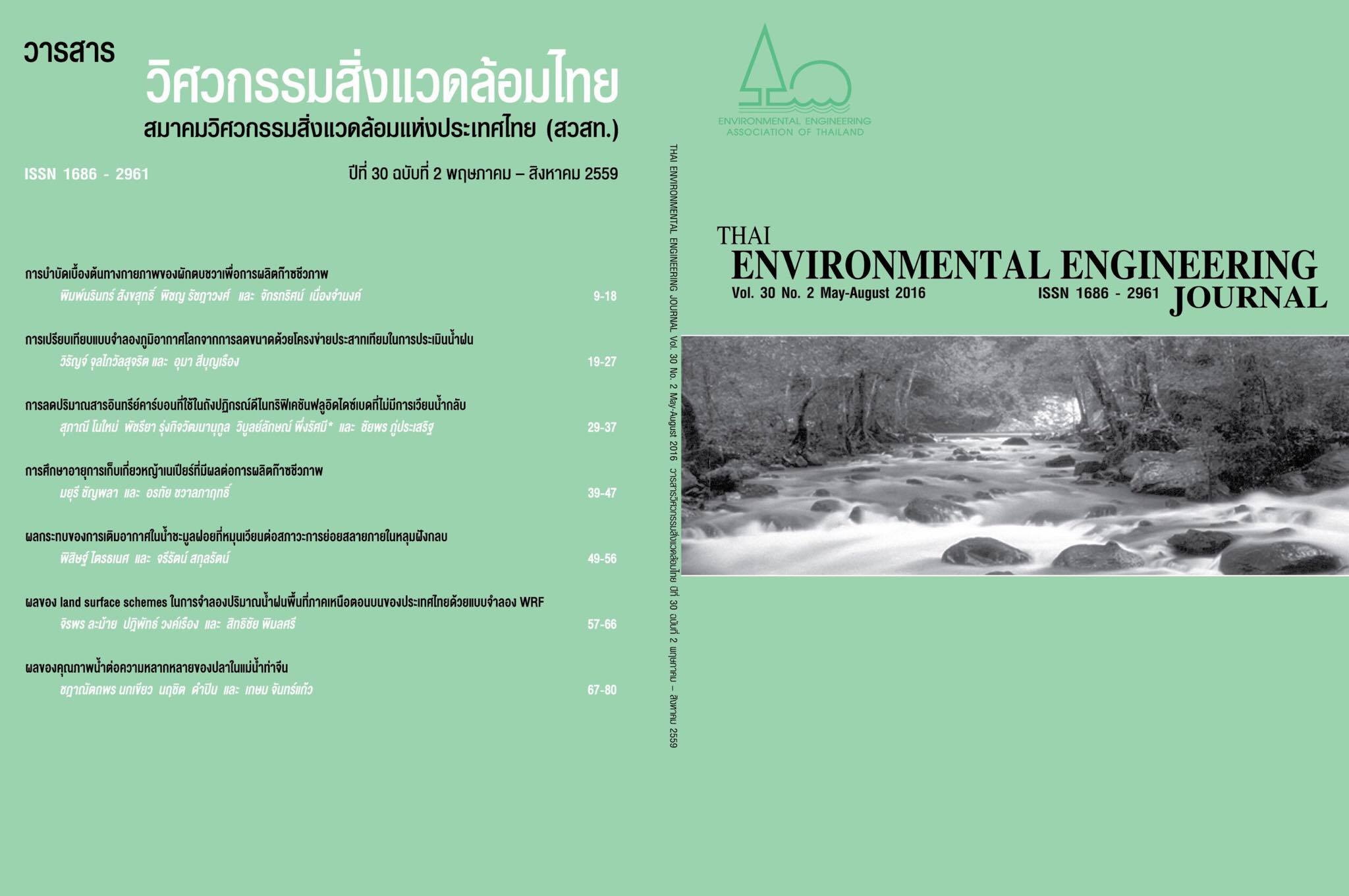Reducing C-source in Non-recycling Denitrification Fluidized Bed Reactor
Main Article Content
Abstract
This research focus on the reduction of carbon source usage in a denitrification process. A fluidized bed reactor (FBR) that operated under anaerobic condition with non-internal recirculation using granular rubber as media. The FBR was fed with a fixed nitrate concentration wastewater as 100 mg/L and glucose was added as external carbon source. The experiment consisted of three experimental approaches. The first step is the FBR start-up in order to enrich the microorganism and induce the biofilm formation on the media. The FBR was fed with wastewater containing COD: NO3- -N of 5:1 and the result showed that nitrate and COD removal efficiencies were 97.59±8.30% and 85.50±9.07%, respectively. Afterwards, the FBR was fed with COD:NO3- - N ratio of 1:1, to evaluate the FBR performance under low COD:NO3- -N ratio. The result presented that the nitrate reduction efficiency was decreased to 25.93±9.89. Then in the last step, the carbon step-fed experiment was performed. The various COD:NO3- -N ratio contained wastewater were fed into the FBR to find the highest reactor performance in term of nitrate and COD removal efficiency. The results demonstrated that at COD:NO3- - N ratio about 3.6:1, the FBR gave the highest nitrate and COD removal efficiencies as 96.86±3.65%and 95.74±1.84%, respectively. Furthermore, the carbon step-fed can be used to reduce the addition of external carbon source in denitrification process, provided high efficiency of nitrate and COD removal.
Article Details
References
[2] Xie, L., Chen, J., Wang, R. and Zhou, Q. 2012. Effect of carbon source and COD/NO3- -N ratio on anaerobic simultaneous denitrification and methanogenesis for high-strength wastewater treatment. J Biosci Bioeng. 113(6): 759-764.
[3] Wanida Horkam. 2011. Nitrate removal by denitrification process in fluidized bed reactor using rubber granule as a media. Master’s Thesis Department of Environmental Engineering, Faculty of Engineering, Chulalongkorn University. (in Thai)
[4] Thipaporn Sirinukulwattana. 2012. Low COD concentration wastewater treatment by anaerobic fluidized bed reactor using rubber granule as a media without internal recirculation. Master’s Thesis Department of Environmental Engineering, Faculty of Engineering, Chulalongkorn University. (in Thai)
[5] Park, J., Ellis, T.G. and Lally, M. 2006. Evaluation of tire derived rubber particles for biofiltration media. WEFTEC. 6: 3217-3230.
[6] Xing, X., Jun, B., Yanagida, M., Tangi, Y. and Unno, H. 2000. Effect of C/N values on microbial simultaneous removal of carbonaceous and nitrogenous substances in wastewater by single continuous-flow fluidized-bed bioreactor containing porous carrier particles. Biochem Eng J. 5: 29-37.
[7] APHA, 2012. Standard Methods for the Examination of Water and Wastewater, 20thed. Washington DC, USA.
[8] Franco, A., Roca, E. and Lema, J. M. 2006. Granulation in high-load denitrifying up flow sludge bed (USB) pulsed reactors. Water Res. 40: 871-880.
[9] Suhr, K.I., Pedersen, P.B. and Arvin, E. 2013. End-of-pipe denitrification using RAS effluent waste stream: Effect of C/N-ratio and hydraulic retention time. Aquacult Eng. 53: 57-64.
[10] Chu, L. and Wang, J. 2011. Nitrogen removal using biodegradation polymer as carbon source and biofilm carriers in a moving bed biofilm reactor. Chem Eng J. 170: 220-225.


